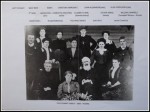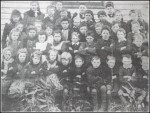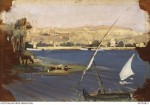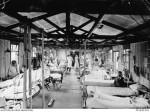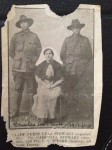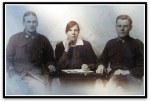STEWART, Lyla Ferguson
Lyla Ferguson Stewart was the 10th of 12 children born to Scottish-born parents John Stewart (1836-1912) and Elizabeth (nee Crawford) (1848-1922). She was registered at birth as 'Eliza'. John had come to Victoria as a young man in the early 1850s, and Elizabeth as a small child with her parents. They married in Terang in 1865. (This and much of the following information about the Stewart family comes from the two Terang and District Pioneer Registers Pre 1900 and The Next Generation Pre 1925).
The Stewart's children were brought up in the small settlement of Keilambete East near Terang in south western Victoria. (Alice Searl was another East Melbourne linked Great War nurse brought up in Terang, see emhs.org.au/person/searl/alice.) One died as a child no doubt succumbing to one of the then common deadly illnesses such as measles or scarlet fever.
The Terang Pioneer Register Pre 1900 gave no occupation for John Stewart (he was a farmer), but described Elizabeth as 'Teacher, Business Woman, Gardener'. Elizabeth Stewart had both borne her husband twelve children by the time she was 41, and established her career as a schoolteacher. She began teaching in her own home in 1870 and then studied privately to qualify as a state registered teacher (Camperdown Chronicle, 11.12.1894). She became headteacher of the East Keilambete School in 1873, 'ceasing only because of the 1894 decision not to employ married women' (Terang Register Pre 1900; see also Camperdown Chronicle, 11.12.1894). She drafted family members to assist her in varying capacities at the school. One of her children was sent to put up a notice at the school which read "Baby coming - will be back tomorrow".
The family were deeply immersed in the local community - in the Presbyterian Church and its sabbath school, the Band of Hope, the Mechanics Institute and the Terang Football Club.
Elizabeth and John had eight daughters. John's obituary noted his 'four unmarried daughters are trained nurses and conduct a private hospital in Terang' (Camperdown Chronicle, 9.3.1912).
Lyla trained as a nurse for three years at the Warrnambool Hospital, where she acquitted herself with distinction. She was subsequently sister in charge there and then at the Hamilton Hospital (Lyla Ferguson Stewart, Service Record; Warrnambool Standard, 22.9.1916).
In mid 1915 she applied to serve in the Australian Army Nursing Service (AANS) overseas. She was 29 years old (but gave her age as 26). She was the first in the family to enlist. Her younger brother Campbell enlisted the following year.
War Service
Lyla Stewart spent almost four years overseas on active service in Egypt (1915-16) and France (1916-1919), working in both Australian and British General Hospitals.
Her service record (naa.gov.au) provides only sketchy details about her activities and movements. The information is confused by material which relates to another L Stewart, in fact Lily Stewart of Ararat and later of Maryborough, which pertain to Lily's Royal Red Cross decoration and Oak Leaf (for Mentioned in Despatches).
The bare bones of Lyla's active service as recorded in her service record and the embarkation roll are these.
- Her application for the Australian Army Nursing Service (AANS) was dated 16 July 1915.
- She gave her address on enrolment in the AANS as East Melbourne, presumably referring to one of the nurses depots there.
- Lyla sailed from Melbourne a few weeks later on 21 August, on board HMAT 'Kyarra' with Victorian and South Australian nurses who were reinforcements for No 2 Australian General Hospital in Egypt and around 250 Light Horse officers and men.
- She suffered a mild attack of measles in April/May 1917 while serving in Wimereux near Boulogne, which hospitalised her in 14 Stationary Hospital and prompted authorities to notify her next of kin.
- Lyla was promoted from staff nurse to the rank of sister on 1 October 1918.
- She returned to Australia on HT 'Wandilla', disembarking in Melbourne on 18 May 1919, and was discharged from the AANS on 25 July 1919.
- Lyla was awarded the 1914-15 Star, the British War Medal and the Victory Medal.
- L Stewart was awarded two decorations, the Royal Red Cross and oak leaf for Mentioned in Despatches - this was in fact not Lyla but Lily Stewart as the difference in signatures and addresses indicate.
- Lyla applied for assistance from the Repatriation Department in 1948.
- On her death in 1972, Lyla's husband William George Thompson provided her details to the Commonwealth War Graves Commission, presumably to allow the Rising Sun emblem on her commemorative plaque.
Fortunately some of Lyla's experiences and thoughts on the war have survived. They appeared in the Terang Express and other local papers, in the form of extracts from her letters and updates of her whereabouts provided by her mother and sisters.
Lyla cabled her mother to say she had arrived safely in Cairo in early October, and that she had been posted to 2 AGH. Like its sister 1 AGH, 2 AGH was located in facilities never intended to be a hospital, in its case the Ghezirah Palace Hotel, situated on an island in the Nile. Nonetheless, these hospitals treated thousands of sick and wounde from the Gallipoli campaign. A letter to her mother written in November or December gave her location as the Mena House, the first site of 2 AGH.
In the letter (Terang Express, 7.1.1916), Lyla described the hospital - hundreds of patients in 45 wards. As well as wounded Australian soldiers, some of whom were 'almost cut to pieces', there were 'crowds of medical cases', mainly British troops with dysentery, jaundice and typhoid. The patients in her ward were looked after by 2 orderlies, 2 Arabs, 2 nurses and one or two convalescent patients.
Lyla was almost overwhelmed by the magnitude of the task at hand:
One feels as if one can't do enough for these soldiers. When one thinks of what they are doing for us, and how they are being cut up and shot, nothing is a trouble to you ... I could get home on a transport almost any time, but I have no wish to yet.
There were lighter notes in the letter however: the daily street scapes with camels and donkeys were just like familiar bible pictures. And having to rush for a tram (from sight-seeing?) so as not to be late on duty.
In early 1916 as the war and Australians moved to the Western Front, medical units followed them. 2 AGH packed up all its equipment and arrived in Marseilles in April. Its main role there was as an infectious diseases hospital, for patients with diphtheria, typhoid and smallpox. Lyla nursed a smallpox patient in quarantine for some time (Warrnambool Standard, 22.9.1916). 2 AGH then moved to Wimereux near Boulogne, though it appears from Lyla's letters to her family that she worked in one or more British General Hospitals in the Boulogne area. There were a number of British hopsitals there, staffed by Australian nurses and British doctors.
All hospitals in the area were often overwhelmed by the volume of casualties from battles in the area, and then by the notorious 'Somme winter' of 1916-17. Nurses were often transferred between the hospitals, Australian and British, when the need arose; Stewart was probably among them - her service record is silent on this.
The official war diary of 2 AGH in late 1916 and 1917 indicated that in the midst of an 'exceptionally heavy workload', patients (and therefore medical staff) were in tents that were subject to the vagaries of the appalling weather, that water pipes froze and later burst, that at least one nurse was severely affected by the cold, and that in September 1917 the hospital had to put in place a 'super crisis expansion' to 1710 beds instead of the usual estanlishment of 1290.
Lyla Stewart spent a brief time in hospital in late April 1917 with measles, described as mild but sufficiently severe for authorities to notify her mother. A patient herself, she was beside herself with anxiety about the fate of her younger brother Campbell Nelson Stewart who was fighting in France with several young men from Terang. She had seen them around Christmas time, and she and her brother were in almost daily contact by letter (Terang Express, 3.7.1917). On 11 April 1917, he was reported missing, and a few weeks later dead. Writing from her bed in the 14th Stationary Hospital, Lyla was heartbroken: 'They say people get over these things, but I never shall.' She hoped when she returned on duty at AGH 'the matron can put me in the busiest ward in the place. I won't mind.' In fact, her brother had been wounded and captured, and was in a prisoner of war camp in Germany, a fact she discovered a few weeks later. He returned, still ill, to Terang to a hero's welcome in 1919 (Camperdown Chronicle, 12.6.1919).
Stewart was anxious to return to 2 AGH. The hospital experienced an influx of casualties in October and November 1917. Work was lighter in the following months but the struggle was against the bitter cold which forced the closure of tented wards. The hospital war diary recorded an influx of troops with machine gun bullets as fighting increased around Arras in March 1918, while in the following May came the first indications of what was to become a very serious health issue in the ensuring months - influenza. The threat of air raids prompted extensive sandbagging and trench digging in the summer of 1918. When the raids eventuated, the matron reported that 'the nurses behaved with perfect calmness, and caried out their duties without flurry or excitement' (War Diary, August 1918).
In late August 1918, the Allied push on the Somme generated another rush of casualties. 2 AGH took only stretcher cases. There was heavy pressure on its beds, and a high rate of evacuations was necessary to keep beds clear for another onslaught of admissions. That month, medical officers and nurses treated bullet and shell wounds, gas poisoning, spinal and head injuries, and dealt with another short-lived influenza outbreak.
Influenza loomed again in October, when the hospital commanding officer reported its management and control were his 'greatest anxiety'. The matron reported patients were helpless, 'utterly prostrated by the disease'. The nursing staff wore gowns and masks and insisted on ward ventilation, and most managed to remain free of the illness.
The extent of the influenza problem, combined with the arrival of winter, virtually overshadowed news of the Armistice on 11 November. 'News of Armistice being agreed received,' the CO wrote, 'Very wet and cold. Extra blankets issued' (War Diary, entry for 11.11.1918). Hostilities might have ceased but the work remained very heavy.
By December 1918, the number of patients was dropping and the influenza epidemic abating. The medical officers undertook refresher courses at other hospitals. Nursing work became easier in some ways but more difficult in others. Ambulant patients confined indoors by winter weather made it harder to keep wards clean and tidy, reported the matron, while her nurses needed 'much tact and wisdom' to deal with restless patients impatient to be repatriated home (War Diary, December 1918).
No new patients were admitted from 11 February, and the hospital emptied as existing patients were evacuated. The nursing staff began transferring to England from mid February. Many took leave in Paris or the south of France, and then returned to Australia.
After the War
Lyla left for Australia in March 1919, one of the nursing staff on HT Wandilla. She arrived in Melbourne after a six week voyage, on 18 May 1919, and was discharged from the AANS on 25 July 1919. She had been on active service for almost four years, and does not appear to have returned to Australia the entire time.
Among the returning troops on board HT Wandilla was William (Bill) George Thompson, an English-born Australian. Lyla's descendants have surmised that a romance was kindled or re-kindled on the ship. They had both served in France, and may have met when Bill was attached to 8 Field Hospital (http://trees.ancestry.com.au).
Lyla and Bill married in Terang on 6 June 1921. Lyla gave her address as Terang and Bill gave his as 257 Victoria Parade, East Melbourne, a place he rented in whole or part from Henry Maddison. His occupation was labourer and hers home duties. According to the Australian Electoral Rolls, by 1934 the couple had moved to Point Neapean Rd, Brighton where they were still living when Lyla died in 1972.
The couple struggled financially throughout the 1930s and 1940s. Between 1921 and 1956, Lyla applied for help on eight separate occasions to the Edith Cavell Trust Fund which provided assistance to sick and needy Victorian Army nurses. (Lyla Thompson, Index Card, Edith Cavell Trust Fund, M291, NAA, Melbourne; Application File, Box M290, NAA, Melbourne.) Her health was never robust and made working difficult. It steadily worsened over the years which she believed was due to the winters she spent nursing in France. Her husband, a labourer, also had poor health. Neither had a repatriation pension. The Fund provided grants ranging from £10 to £20 for assist them in their 'necessitous circumstances'.
Lyla's age at death was given as 78; she was in fact 86 according to her birth registration in 1886.
Lyla applied for assistance from the Repatriation Department in 1958. She died in Heidelberg Repatriation Hospital. Lyla was cremated at Springvale, Melbourne after her death. William provided details to the Commonwealth War Graves Commission, presumably requesting permission for the appropriate emblems on her commemorative plaque.
Lyla Stewart featured in the East Melbourne Historical Society's 2015 exhibition, 'Gone to War as Sister: East Melbourne Nurses in the Great War'. Her panel can be seen at Gone to War as Sister - exhibition panel 12
Many thanks to Lois Morrison for photographs of Lyla with her family.
Janet Scarfe, Adjunct Research Associate, Monash
29 January 2017


